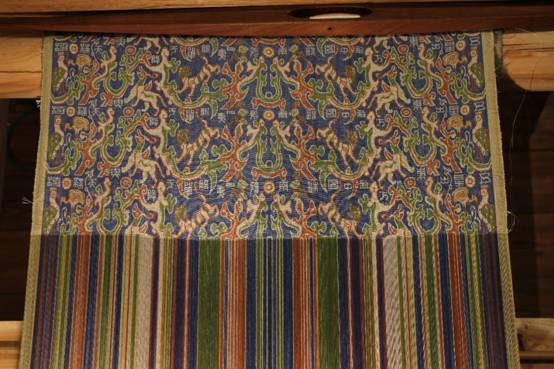
China National Silk Museum successfully completed the replication of the jin-silk with the characters “wu xing chu dong fang li zhong guo”.
On the morning of May 20, 2018, the interim report of "wu xing chu dong fang li zhong guo" Han jin-silk (hereinafter referred to as "wu xing" jin-silk) restoration project was held in the International Center of China National Silk Museum (hereinafter referred to as NSM). Luo Jing and other leaders from the State Administration of Cultural Heritage, Liu he and Cao Hong, the director and the deputy director of the Zhejiang Municipal Administration of Culture Heritage, Li Jun, the deputy director of the cultural heritage bureau of Xinjiang Uygur Autonomous region, Qi Dongfang, the professor of the school of Archaeology and Museology of Peking University, and the member of the Niya Archaeological team, attended the meeting. This meeting was hosted by Zhou yang, assistant curator of NSM. The project executor, Luo Qun, demonstrated the weaving process. The curator of NSM Zhao Feng introduced the research process of "wu xing" jin-silk restoration project from three aspects: first, unearthed and studied the "wu xing" jin-silk, second, unearthed and studied the Laoguanshan loom, and third, used the research results of Laoguanshan loom to replicate "wu xing" jin-silk. It was the original technology restoration that Han loom woven Han jin-silk. Experts highly praised the replication work of "wu xing" jin-silk, and believed that this replication has been successful.
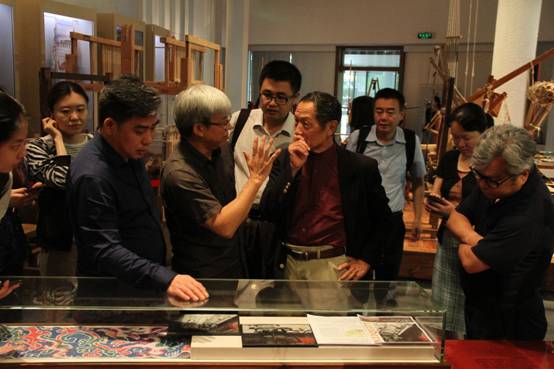
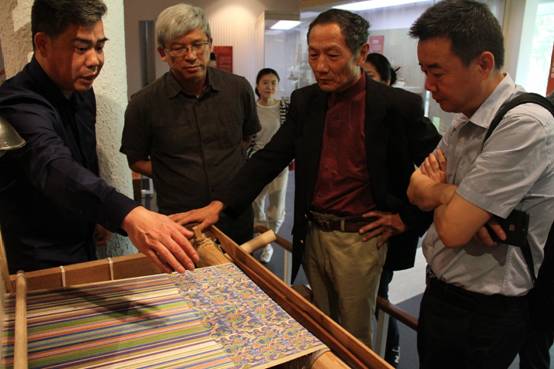
The curator of NSM Zhao Feng introduced the research process of "wu xing" jin-silk restoration project from three aspects
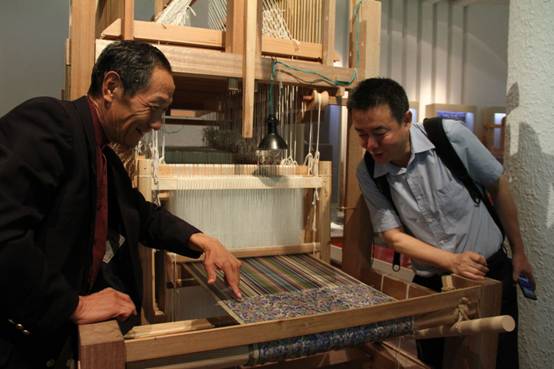
Li Jun, the deputy director of the cultural heritage bureau of Xinjiang Uygur Autonomous region, Qi Dongfang, the professor of the school of Archaeology and Museology of Peking University, both of whom discovered the jin-silk with their teams.
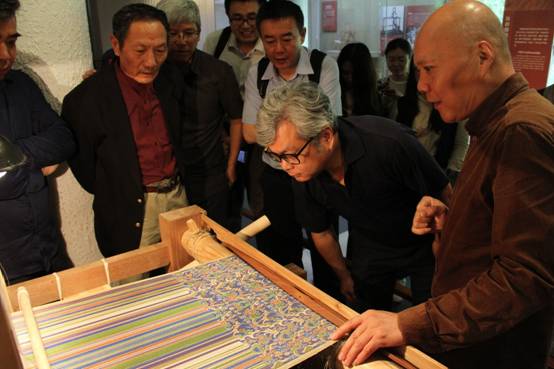
Liu he, the director director of the Zhejiang Municipal Administration of Culture Heritage was listening to the process
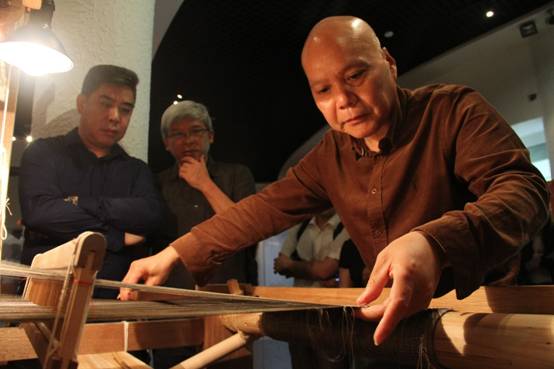
The project executor, Luo Qun, demonstrated the weaving process.
In 1995, the Niya Archaeological team discovered "wu xing" jin-silk at Tomb 8 of Nia No.1 Cemetery, causing a great sensation. Chinese Silk also invited the unearthed relics of Niya including "wu xing" jin-silk to be exhibited in Hangzhou in 2000 by holding a special exhibition. During the exhibition, the curator Zhao Feng based on the research of Captain Yu Zhiyong of the Niya Archaeological team, restored the pattern of "wu xing" jin-silk and obtained preliminary results.
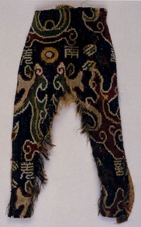
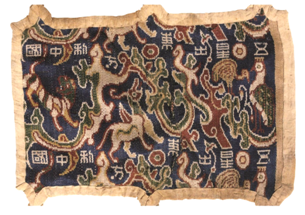
the Niya Archaeological team discovered "wu xing" jin-silk at Tomb 8 of Nia No.1 Cemetery

the pattern of "wu xing" jin-silk restored in 1997
In 2013, a pattern loom model of the Western Han Dynasty was unearthed at the Han Tomb in Laoguanshan, Chengdu, Sichuan Province. NSM led the Chengdu Museum, the Institute for History of Natural Sciences, the Chinese Academy of Sciences and other institutions to undertake the National Compass Project, restoring the Western Han Dynasty loom and weaving technology. This study solved the problem of the types of Han loom and provided a solid foundation for the original technology restoration of Han brocade. The result was published in 2015 and then published in the internationally renowned professional journal Antiquity, attracting the attention by the peers in archaeological and scientific history from all over the world.
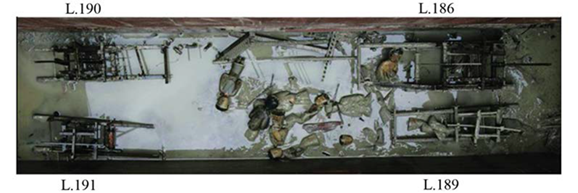
Laoguanshan pattern loom in 2013
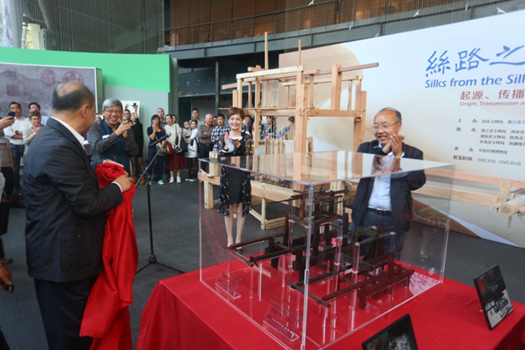
restored the Western Han Dynasty loom in 2015
In 2015, with the approval of the State Administration of Cultural Heritage, Xinjiang Autonomous region Administration of Cultural Heritage commissioned NSM to restore "wu xing" jin-silk. On the basis of earlier research, NSM officially began to restore "wu xing" jin-silk.
In January 2017, technicians from NSM, such as Luo Qun and Liu Jian, went to Xinjiang to collect and analyze the fabric information of "wu xing" jin-silk. Then, the key was to set a complete replication target. Zhao Feng once again studied the patterns and words in "wu xing" jin-silk. After comparing the previous research materials and unearthed cultural relics, finally he determined that the patterns and words were restored as “wu xing chu dong fang li zhong guo zhu nan qiang si yi fu dan yu jiang yu tian wu ji”. Based on this, the main technicians of the team, Luo Qun and Longbo, drew
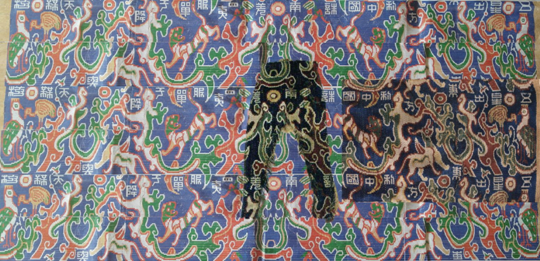
the pattern of "wu xing" jin-silk
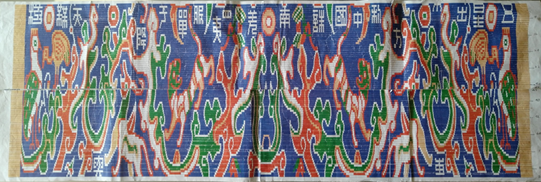
the plan of weave of "wu xing" jin-silk
More importantly, NSM decided to replicate "wu xing" jin-silk by the pattern loom which was restored based on the loom model of the Han Dynasty unearthed from the Han Tomb of Laoguanshan in Chengdu, Sichuan Province. In February 2017, Luo Qun led his team to begin the work of drafting and weaving on the loom. After more than one years, the work of drafting has been completed by using 10470 warps, 84 pattern heddles and 2 ground heddles. After the complex drafting finished, carried on the weaving, finally successfully replicated "wu xing" jin-silk.
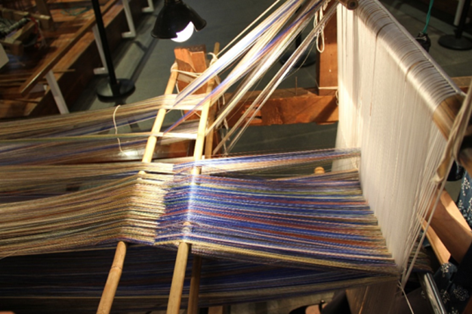
drafting during the replicating

84 pattern heddles

the loom used for replicating "wu xing" jin-silk
In the process of replicating "wu xing" jin-silk, the team realized the limitations of hook-shaft pattern loom setting and gained more experiences about the plant dyes and traditional dyeing techniques. The technical difficulty of the replication of "wu xing" jin-silk was in the loom design and loom setting. There was no precedent for the weaving of warp by a single independent hook-shaft pattern loom in the world. The most difficult problems in weaving are: first, the clarity level of jacquard; second, the contradiction between the thin degree and the strength of heddles; and third, the density of the warp lines. Luo Qun and the director of technical department Wang Ziqiang, member Long Bo, consulted with weaving technicians actively, one by one to solve the various problems, and finally completed the replication of "wu xing" jin-silk.
Experts commented on the work of "wu xing" jin-silk reproduction project at the meeting. Qi Dongfang believed that the reproduction of "wu xing" jin-silk has been very successful. In the process of watching the replica loom weaving "wu xing" jin-silk, he was very excited. The successful replication of "wu xing" jin-silk has greatly promoted the study of the fabric unearthed by Nia and has made an important contribution to the study of the Silk Road. Li Jun was also a member of the Niya Archaeology team. He reviewed the excavation process and described the importance of "wu xing" jin-silk. He also thought that it was of great significance to combine the replication of "wu xing" jin-silk with the model of the Han Dynasty loom of Laoguanshan, which was not a simple replication study, but a very complex research project.
Finally, Luo Jing summarized the interim report of "wu xing" jin-silk restoration project. She believes that the replication work from loom models to fabrics restored a perfect research process. Chairman Xi asked for the cultural relics be "alive". This required us to conduct in-depth studies on the real values of history, art, and science of cultural relics. The replication of "wu xing" jin-silk by NSM was an dig exploration of the scientific value of the cultural relics. The exhibition of the museum needed a lot of academic work to support, to be an academic museum. She believed that the loom exhibition, which would open on May 30, would cause a great sensation. She hoped that NSM would adhere to the principle of being an academic museum and continue to make efforts to bring more surprises to the public.
The curator Zhao Feng declared that NSM would carry out further research work in accordance with the requirements of the contract, and would continue to do research from the perspective of fabric dyes, and also hoped that could use isotopic tracer and other methods to explore the origin of silkworm silk of "wu xing" jin-silk.
 Pay attention to us
×
Pay attention to us
×